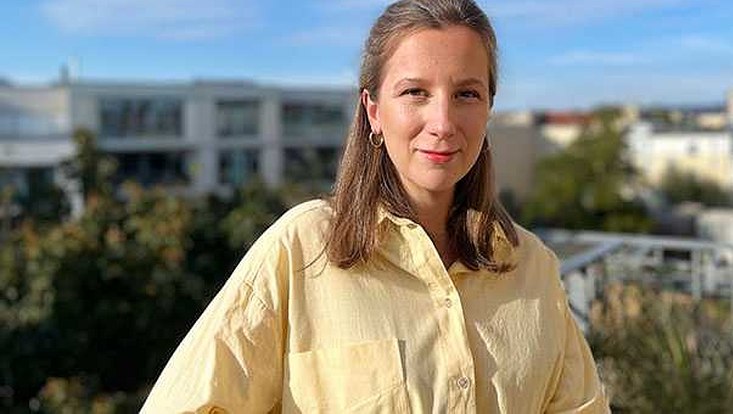Dr. Kira Jürjens

Curriculum
Kira Jürjens is a literary scholar specializing in the history of literature and knowledge, literary representations of space and the connections between literature and material culture.
She studied German literature and art history in Berlin and Paris. Her dissertation on textiles in nineteenth-century literary interiors was written in the SNF-project "Interieur und Innerlichkeit" at the Université de Lausanne and was published by Böhlau-Verlag in 2021.
Since 2019, she has been a research assistant at the Institute for German Literature at Humboldt University in Berlin. She is currently working on a habilitation project on compression as a literary figure of thought.
Publications (selection)
- with Ulrike Vedder (eds.): Kataloge. Medien und Schreibweisen des Verzeichnens. Zeitschrift für Germanistik, NF XXXII, H. 1 (2022).
- Überhitzte Räume. Wärmelehre des Luxus (Alexandre Dumas fils und Zola), in: Orte des Überflusses. Topographien des Luxuriösen, ed. by Maria Magnin, Raphael Müller and Hans-Georg von Arburg, Berlin: De Gruyter 2022, pp. 177–212.
- Der Stoff der Stoffe. Textile Innenräume in der Literatur des 19. Jahrhunderts, Köln/Weimar: Böhlau 2021.
- Ein weiteres Kleid: Häuslich-Textile Umwelten im 19. Jahrhundert, in: NTM Zeitschrift für Geschichte der Wissenschaften, Technik und Medizin 29, 1 (2021), pp. 11-43.
- with Lena Abraham, Edith Anna Kunz and Elias Zimmermann (eds.): Fenster – Treppe – Korridor. Architektonische Wahrnehmungsdispositive in der Literatur und in den Künsten, Bielefeld: Aisthesis 2019.
Research project: Density. Compression as a Literary Figure of Thought
The research project aims to historically and systematically contour the concept of density on the basis of figures, scenarios, and practices of compression, and to investigate its interconnectedness with chemical-physical, psychological, physiological, and sociological knowledge. This is based on the observation that since the second half of the 18th century, aesthetic and poetic quality have increasingly been defined in relation to phenomena of density and compression operations.
This is closely linked to questions of form and genre: the category of 'density' becomes virulent at the very moment when formal criteria of rule poetics are broken down and prose forms in their unbound breadth have to assert their place in the genre system. In the process, density and compression also gain compensatory relevance on the plot level of literary texts. The project examines how compression is staged as a prerequisite for the formation of imaginative and representational power following a (proto)thermodynamic logic.
In four thematic blocks, the project deals with the connections between (1) (poetic) force and density since the end of the 18th century, (2) metaphors and motifs of compressed matter (bouillon cube, brilliant and briquette) as store and donor of (poetic) force, (3) the relevance of density in concepts of time and experience around 1900, and (4) topologies of density as they are developed in city and housing discourses in the 20th century.
Research results: Density. Compression as a Literary Figure of Thought
The notion of 'dichte Dichtung' is as common as it is vague. While there is no etymological connection between the terms which have different roots, around 1800 poetic quality becomes associated with a state of density and operations of condensation. The cultural assertiveness of this figure of thought is not solely due to the phonetic similarity of the play on words, but must be considered in the wider context of the interweaving of the history of knowledge.
In ancient natural philosophy, condensation is a fundamental process of change that can be used to explain the various natural phenomena that can be traced back to a primary substance. Condensation functions as a formative principle with its own potential for creation and transformation, which makes it particularly attractive for poetic configurations. As a relational parameter and qualitative correlate to mass, density still resists pure quantification in the context of 17th and 18th century physics and (al)chemistry (van Helmont, von Guericke, Mariotte, Boyle, Lavoisier). Around 1800, condensation establishes itself as a universal and universalising principle that gives power and form, and embarks on a steep career through the various formations of knowledge.
In an imagery reminiscent of chemical-physical experimental arrangements, the concept of condensation - even before its conceptual connection with poetry in the word games of German Romanticism - gained importance as an operation for combining perceptual data, material masses and a wealth of objects into a 'beautiful whole' as early as the aesthetic discussion around 1750 (Bodmer, Breitinger, Baumgarten, Meier and Sulzer). Condensation serves as a model of thought to counteract the danger of fragmentation and dispersion that went hand in hand with the expansion of the artistic field of perception to include the 'lower senses'. Scenarios and figures of a 'Mannigfaltigkeit' that can be grasped 'at a glance' as well as metaphors of the diamond or the focal point are of particular relevance here. When density and condensation ultimately become central elements in the cultural theories of the 19th and 20th centuries, this is not simply an adaptation of a physical concept. Rather, it is also an aesthetic concept that has developed a literary life of its own since the end of the 18th century that needs to be analysed more closely.
